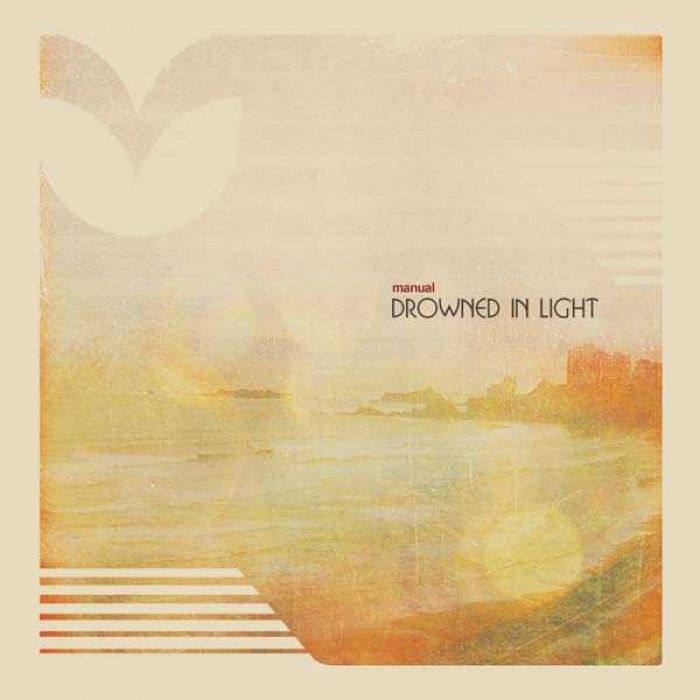Drowned in Light by Manual (Review)

When I last reviewed Manual, it was for 2007’s Lost Days, Open Skies and Streaming Tides, a two-disc collection of b-sides, compilation tracks, remixes, and other odds and ends. And by the time I was finished with that release, I concluded, or at least hoped, that it was a harbinger of sorts, that it represented a desire by Munk to clear out any musical baggage and start exploring some new sonic territory.
As much as I like Munk’s music in spirit and theory, the truth is that a little bit of Manual goes a long way for me. I love his ethereal guitars and instrumental soundscapes, but they’re so smooth and crisp, so polished and well-produced, that they’ve always blended together in the long run. As such, I found myself eagerly anticipating something truly new from the guy.
2008 brought us Confluence, another one of Manual’s more ambient-minded releases — and his weakest of that sort (I’ve always preferred 2004’s The North Shore for my Manual bliss-out moments). But now it’s 2010 and Drowned in Light is here, and it represents the first real evidence that Munk is venturing towards a new place, musically. Which makes the album fascinating but also frustrating, because he’s not there yet.
If you were to distill Drowned in Light, you’d essentially end up with three different sounds. The first sound is balmy and acoustic-oriented, and lends itself well as a soundtrack for the sun-drenched tropical locations that have graced Manual’s artwork over the last six years or so. There are electronic facets (e.g., swirling guitars and synth atmospherica, programmed drums) on “Biarritz” and “Empty Inside” but the focus is on breezy guitar structures that would be perfect for enjoying warm summer evenings on the beach.
The second sound is a further refinement of his trademark shoegazer aesthetic, one that takes the spaced-out sounds of Slowdive’s “Souvlaki Space Station” and the haziness of early Verve and brings them into the 25th century, thanks to Munk’s inimitable programming and production talents (e.g., “Blood Run,” “Issa”).
These first two sounds are nice enough, but they don’t represent anything we haven’t heard before on a Manual release (though, in the case of “Afterimages” and “Morning Glass 1982,” they are some of the finest examples of what Munk has done so well so many times to date). The third sound that makes up Drowned in Light, however, instantly piques my curiosity and represents both the most retro and forward-thinking music that Munk has done in a long time, maybe ever.
Munk’s music has often been swathed in nostalgia, specifically that of a highly-stylized and idealized version of the 1980s (just listen to a few tracks from 2005’s Azure Vista). However, Drowned in Light’s best moments reveal a fascination with the 1970s, specifically the analog synth sounds often associated with Germany’s kosmische movement. And it’s here, in the process of traveling back to the roots, if you will, of the ambient/electronica genres that Manual is often placed in, that Jonas Munk sounds liberated for the first time in a long time.
We hear a few analog gurgles in Drowned in Light’s opening moments, but they’re largely hidden behind the shimmer of the album’s first tracks. It isn’t until “Phainomenon” that the old-timey synth sounds come to the forefront as Munk layers hazy, slow-mo drifts of Cocteau-sy guitars over Kraftwerk-like assembly line beats, synth arpeggios, and analog squiggles. It’s an intriguing synthesis, but the best is still yet to come: “Pulsations” is where Munk truly delivers on the promises of his yesteryear fascination.
Put simply: once that sinister, undulating synth-bassline establishes itself as the song’s foundation, prepare yourself for blast off. With that as a launchpad, Munk proceeds to explore the furthest reaches of the galaxy with a barrage of sounds that are among the trippiest and most enthralling he’s ever recorded. And when he brings in some of his trademark shoegazer sounds on the song’s pseudo-bridge, it’s just the icing on the cosmic cake.
It’s on a track like “Pulsations” that I get truly excited about Manual in a way that I haven’t been in a long time. It’s the sound of Munk going someplace that he’s never really gone before while at the same time, incorporating the best of what he’s done to date. It’s what I hope is a representation of Manual 2.0. He’s not there yet — but if tracks like “Phainomenon” and “Pulsations” are any indication, he’s approaching at lightspeed.